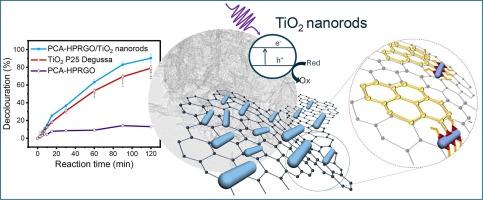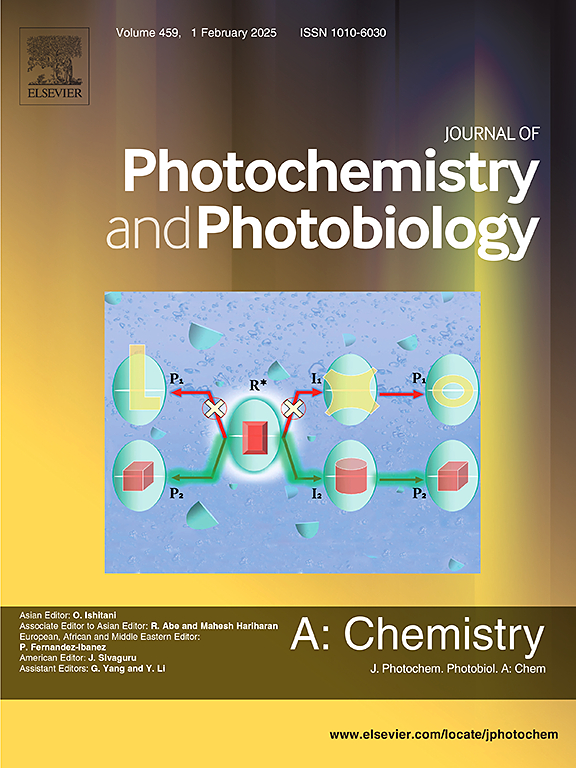Photocatalytic nanocomposite based on pyrene functionalized reduced graphene oxide in situ decorated with TiO2 nanorods
IF 4.1
3区 化学
Q2 CHEMISTRY, PHYSICAL
Journal of Photochemistry and Photobiology A-chemistry
Pub Date : 2024-11-10
DOI:10.1016/j.jphotochem.2024.116149
引用次数: 0
Abstract
Hybrid nanocomposites based on 1-pyrene carboxylic acid (PCA) functionalized High Porous Reduced Graphene Oxide (HPRGO) sheets, decorated with oleic acid (OLEA)-coated TiO2 nanocrystals (NCs), have been obtained by means of an in situ colloidal route, starting from titanium isopropoxide (TTIP) precursor, in presence of OLEA surfactant and trimethylamino-N-oxide dihydrate (TMAO) base catalyst. The effect of the synthesis parameters, namely the PCA-HPRGO:TTIP w/w and the OLEA:TTIP molar ratio, on the morphological, spectroscopic and structural properties of the nanocomposites, has been explored, to achieve highly crystalline TiO2 nanostructures, with a reproducible control on morphology and crystalline phase (anatase). The TiO2 NCs have been found to effectively heteronucleate and grow onto the –COOH groups of the PCA molecules anchoring onto the HPRGO basal plane by aromatic π-π stacking interactions. The OLEA ligand coordinating their surface endows the nanocomposites with dispersibility in organic solvents, with a morphology dictated by the PCA coordinating sites, OLEA, and the mode of the TMAO supply to the reaction mixture. A significantly higher coating density has been found for the TiO2 in nanorods (NRs) morphology, which organize in a uniform and high packed layout onto the PCA-HPRGO basal plane. The TiO2 NRs decorated PCA-HPRGO nanocomposites (TiO2 NRs/PCA-HPRGO) have been tested as photocatalysts for the degradation of methyl red (MR) and nalidixic acid (NA) under UV- and solar-light irradiation. Their photocatalytic activity has been evaluated against TiO2 reference and commercial nanostructures and discussed in terms of electronic level alignment between the hybrid nanostructure components, considering the role of the PCA anchoring molecule at the interphase.

基于芘官能化还原氧化石墨烯与二氧化钛纳米棒原位装饰的光催化纳米复合材料
以异丙醇氧化钛(TTIP)为前驱体,在 OLEA 表面活性剂和二水三甲胺氧化物(TMAO)基催化剂的作用下,通过原位胶体路线获得了基于 1-苯乙烯羧酸(PCA)功能化高多孔还原石墨烯氧化物(HPRGO)薄片和油酸(OLEA)包覆的二氧化钛纳米晶体(NCs)的混合纳米复合材料。研究人员探索了合成参数(即 PCA-HPRGO:TTIP w/w 和 OLEA:TTIP 摩尔比)对纳米复合材料形态、光谱和结构特性的影响,从而获得了高结晶度的 TiO2 纳米结构,并对形态和结晶相(锐钛型)进行了可重复控制。研究发现,TiO2 NCs 通过芳香族 π-π 堆积相互作用,有效地异质成核并生长在锚定在 HPRGO 基底面上的 PCA 分子的 -COOH 基团上。配位其表面的 OLEA 配体赋予了纳米复合材料在有机溶剂中的分散性,其形态由 PCA 配位位点、OLEA 以及向反应混合物中提供 TMAO 的方式决定。在纳米棒(NRs)形态中,TiO2 的涂层密度明显更高,它们在 PCA-HPRGO 基面上形成了均匀、高度密集的布局。在紫外线和太阳光照射下,TiO2 NRs 装饰的 PCA-HPRGO 纳米复合材料(TiO2 NRs/PCA-HPRGO)作为光催化剂进行了降解甲基红(MR)和萘啶酸(NA)的测试。对照 TiO2 基准纳米结构和商用纳米结构对它们的光催化活性进行了评估,并考虑到相间的 PCA 锚定分子的作用,从混合纳米结构成分之间的电子水平排列角度对它们的光催化活性进行了讨论。
本文章由计算机程序翻译,如有差异,请以英文原文为准。
求助全文
约1分钟内获得全文
求助全文
来源期刊
CiteScore
7.90
自引率
7.00%
发文量
580
审稿时长
48 days
期刊介绍:
JPPA publishes the results of fundamental studies on all aspects of chemical phenomena induced by interactions between light and molecules/matter of all kinds.
All systems capable of being described at the molecular or integrated multimolecular level are appropriate for the journal. This includes all molecular chemical species as well as biomolecular, supramolecular, polymer and other macromolecular systems, as well as solid state photochemistry. In addition, the journal publishes studies of semiconductor and other photoactive organic and inorganic materials, photocatalysis (organic, inorganic, supramolecular and superconductor).
The scope includes condensed and gas phase photochemistry, as well as synchrotron radiation chemistry. A broad range of processes and techniques in photochemistry are covered such as light induced energy, electron and proton transfer; nonlinear photochemical behavior; mechanistic investigation of photochemical reactions and identification of the products of photochemical reactions; quantum yield determinations and measurements of rate constants for primary and secondary photochemical processes; steady-state and time-resolved emission, ultrafast spectroscopic methods, single molecule spectroscopy, time resolved X-ray diffraction, luminescence microscopy, and scattering spectroscopy applied to photochemistry. Papers in emerging and applied areas such as luminescent sensors, electroluminescence, solar energy conversion, atmospheric photochemistry, environmental remediation, and related photocatalytic chemistry are also welcome.

 求助内容:
求助内容: 应助结果提醒方式:
应助结果提醒方式:


